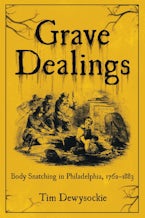A history of the secret cadaver trade in America’s first capital city.
In the 18th century the first American medical school was established in Philadelphia. Following the model of European universities, anatomical lectures were conducted with cadavers. But where did the bodies come from? Dissection was viewed as a fate worse than death, and the only legal source of “stiffs” was executed criminals. But there were not enough. As the medical profession and its need for “anatomical material” grew, a new, macabre practice emerged: body snatching.
Body snatchers secretly obtained bodies from cemeteries and sold them to medical schools for dissection. But how did body snatching work? How did body snatchers and medical schools avoid getting caught, and what happened when they did? How did the era of the body snatchers end? Grave Dealings: Body Snatching In Philadelphia, 1762-1883 digs through archives to unearth the forgotten history of a time of graveyard patrols and anatomy riots, when the dead needed protection from the living. Philadelphia pioneered and became the center of American medical education and practice–and body snatching–in the 18th and 19th centuries.
Grave Dealings explores the social, cultural, practical, and legal aspects of body snatching in America’s first capital city and relates it to the continuing ethical struggles that surround the treatment of human remains to this day.
Introduction: Death, Disinterment, and Dissection in Philadelphia
“Now and Then One From the Potter’s Field”: Washington Square and the First American Medical School
“Board of Buzzards”: Dissecting the Destitute in Blockley Almshouse
“The Philadelphia Method”: Secret Agreements and the Cadaver Trade
“To Delve For Science In The Dreary Grave”: Body Snatching in Popular Culture
"Beating the Body Snatchers": Coffin Torpedos, Cages, and Cremation
“A Law To Protect Burial-Grounds”: Retribution for “Resurrectionists”
“Jefferson’s Resurrection Keys”: Body Snatching On Trial
Afterword: The Legacy of Body Snatching

